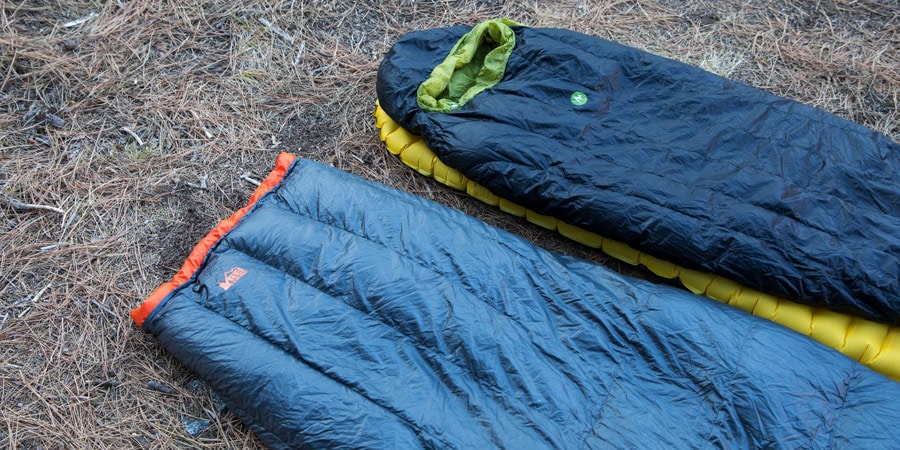Your sleep system—made up of a sleeping pad and some form of camp bedding, like a sleeping bag—is a crucial component to any outdoor overnight. When paired properly, your sleep system can keep you cozy and help you achieve Goldilocks-level warmth all night. But a sleeping bag isn't your only option when it comes to bedding. Enter: the camp quilt.
A quilt is an increasingly popular alternative to sleeping bags, especially among thru-hikers and other long-haulers, thanks to its light weight and versaility. But what exactly is a quilt and how does it compare with a sleeping bag?
In this article, we explain the main differences between a camp quilt and a sleeping bag and how to decide which is best for your next adventure.
Quilts
What is a quilt?
Many camp and backpacking quilts look similar to sleeping bags, just minus that bottom layer of fabric. While a sleeping bag provides cocoonlike coverage, a quilt provides only a top layer. Camp quilts are made using performance materials and include down or synthetic fill for extra warmth. Some have enclosed toe boxes and zippers. Like sleeping bags, they come in versions for both camping and backpacking, including ultralight options.
What are the benefits of a quilt?
One main benefit of a camp or backpacking quilt is that less material means they're smaller and lighter than many sleep sacks, says Tim Bird, retail sales manager at the REI store in Farmington, Utah, who has completed the Appalachian Trail.
These covers are also great for those who tend to sleep hot, are backpacking in warmer weather or like to adjust their temperature throughout the night—just lift one side of the quilt to let out hot air.
"Quilts offer adaptable warmth, serving as a cozy blanket during mild nights or securing tightly around the body for enhanced insulation in chillier conditions," Bird says. This versatility allows users to adjust their sleep setup according to the weather and their internal thermostat.
They're also a versatile option for adventures beyond backpacking, like as an extra layer when car camping or when having a summer bonfire in the backyard.
“The thing I love about quilts is their high frequency of use because we're probably going to use them more for our lifestyle than just adventure,” says Carlos Rodriguez, a retail sales specialist at the REI store in Wichita, Kansas.
Like sleeping bags, quilts come in synthetic and down filling and choosing between the two is much like selecting between a down or synthetic sleeping bag. (Related reading: Down vs. Synthetic: Which Insulation Is Right for You?)
Down quilts provide superior warmth-to-weight ratio and packability, Rodriguez says, adding that when used correctly, a down quilt will have a better warmth-to-weight ratio compared to a down sleeping bag of the same temperature rating (remember: less fabric = less weight). However, down products are typically more expensive than alternatives. If you have ounces to spare, synthetic quilts are often a more affordable option. And because synthetic insulation dries quicker than down and can insulate when wet, synthetic quilts are often a better choice for rainy conditions. (Related reading: Understanding Sleeping Bag Temperature Ratings)
What are the drawbacks of a quilt vs. a sleeping bag?
Because quilts don't provide the same level of enclosure as a bag, they can leave sleepers more exposed to drafts. For this reason, they aren't ideal for conditions below freezing, Bird says.
Additionally, quilts can involve setup: While you don't have to attach your quilt to your sleeping pad, doing this keeps the two together if you toss and turn at night. However, learning how to secure your quilt may require some practice. Most come with a cord that slips behind a sleeping pad to keep it in place, and you can also buy elastic pad straps for extra security.
Camp Quilts at a Glance:
Pros | Cons |
|---|---|
Lightweight and compact, ideal for ounce-counting backpackers and thru-hikers | Less insulation and protection from cold drafts compared with sleeping bags |
Versatile design allows for easy temperature regulation | Requires a sleeping pad for optimal warmth and comfort |
More freedom of movement compared with sleeping bags | Learning curve for effective setup and temperature regulation |
Can be used for non-camping activities |
Sleeping Bags
What is a sleeping bag?
Sleeping bags remain a tried-and-true outdoor gear staple. Their fully enclosed design traps heat, making them an ideal choice for colder conditions or higher-elevation environments.
Sleep sacks come in different shapes, including mummy, semirectangular, double and rectangular. These designs cater to different body types, sleeping preferences, and sleeping positions. (Related reading: How to Choose Sleeping Bags for Camping and How to Choose Sleeping Bags for Backpacking)
What are the benefits of a sleeping bag?
Sleeping bags are fairly straightforward to use. They require minimal adjustment to create a cozy sleeping environment, making them a solid option for beginners who prefer a hassle-free outdoor adventure or anyone who feels intimidated by the moving pieces of setting up a quilt.
They also stay put. Even if you toss and turn at night, your sleeping bag is more likely to hold fast than a quilt. However, Bird says that those who want more freedom to sprawl may prefer a quilt even if it doesn’t stay in place throughout the night.
What are the drawbacks of a sleeping bag vs. a quilt?
Traditional sleeping bags tend to be bulkier and heavier than quilts, thanks to the extra fabric. While sleeping bags come in ultralight versions, an ultralight quilt can often provide even more space and weight savings for backpackers optimizing their gear setup.
And unlike a camp quilt, an enclosed bag provides less room to move around. For this reason, it’s important to consider which shape best suits your needs. Generally, a rectangular bag will allow the most wiggle room but provide the least amount of insulation, while a mummy bag will feel the most restrictive but provide the most warmth. (Related reading: How to Choose Sleeping Bags for Backpacking)
Sleeping Bags at a Glance:
Pros | Cons |
|---|---|
Full-body coverage and insulation for added warmth and protection. | Generally bulkier and heavier than quilts |
Better suited for cold-weather camping and winter adventures. | Limited mobility and ventilation |
Wide range of designs and styles to accommodate different preferences | Less versatile for alternative uses |
The Verdict
Choosing between quilts and sleeping bags ultimately comes down to factors like your adventure style, goal pack weight, sleeping habits and the weather conditions. If you value versatility and weight savings, quilts may be the ideal choice for your outdoor adventures. If a straightforward setup or use in below-freezing weather is your priority, a sleeping bag might better suit your needs.
Regardless of your choice, it's essential to consider factors such as temperature rating, insulation type and sleeping pad compatibility to ensure a comfortable and safe outdoor experience. Whether you're embarking on a rugged backpacking trip or enjoying a leisurely weekend at camp, the right bedding can make all the difference in your outdoor slumber. (Related reading: Everything You Need to Know About Sleep Systems)
Related Reading:


